|
African Other Ranks in the Togo Polizeitruppe |
|
 |
 |
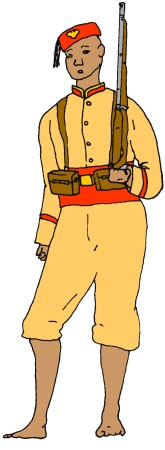 |
 |
 |
|
Figure 1
Police
NCO
c1887 |
Figure 2
Police Soldier
c1892 |
Figure 3
Police
Soldier
c1894 |
Figure 4
Police
Soldier
c1914 |
Figure 5
Police
Soldier
c1914 |
Uniforms of the African Other Ranks of
the Togo Polizeitruppe
Uniforms 1880s-1890s
The evolution of the early Togo Polizeitruppe uniforms has been described by
several sources (including Haupt, Abbott, Somers and Schneider- see
Book
Reviews Page) but very little photographic evidence has been seen to
verify these changes.
The earliest uniforms of the Togo Polizeitruppe were white and of naval cut
with full length sleeves and three quarter length trousers. The naval
collar was edged in red and a red sash was worn around the waist under
the belt. Headdress consisted of a plain red felt fez with a blue/black
tassel. No boots or puttees were worn.
In 1887 this uniform was
replaced by a new blue uniform. This uniform is described as consisting of a dark blue tunic with
brass buttons and red piping and shoulder straps, and knee length dark blue trousers.
Headgear consisted of a white cap with a white peak (this has not so far ben
verified in period photographs).
The cap was replaced in 1890 with what is described as a Prussian
Infantry cap (in which case it would also be dark blue, with red piping
and hatband and possibly without a peak) with a small imperial cockade
(again this Prussian style cap has not so far been verified in period
photographs). A red
sash was still worn around the waist with the blue uniform.
Uniforms 1890s-1914
In 1891 new headgear was introduced
in the from of a red rolled felt fez similar to that worn in Cameroon
with a brass imperial eagle badge and a blue/black tassel. This was
followed in 1894 by a new khaki uniform, similar to those worn by African other ranks in Cameroon and
East Africa. The Togo Polizeitruppe version had five or six brass
buttons down the front and no pockets or shoulder straps (although
variations existed and at least one photograph shows plain shoulder straps
worn by the Polizeitruppe band in Lome). The standing collar and cuffs had a
red lace bar around them. The tunic was usually
worn tucked into a red sash around the waist. The trousers were of matching
khaki and usually gathered below the knee (although some photographs show
NCOs wearing full length trousers). As with previous Togo Polizeitruppe
uniforms they were usually worn without puttees or boots (although at least
one photograph shows an NCO wearing puttees sometime between 1910 and 1914).
From about 1910 onwards a dark
khaki peaked cap began to replace the fez. It had a black leather peak and a
red hatband with a small imperial cockade on the front. From photographic
evidence it appears that this cap was first issued to NCOs, while other
ranks still wore the fez. Later photographs show whole units wearing the
peaked cap although some of the Togo Polizeitruppe may have retained the fez
up until 1914.
Some sources (most notably the "Deutsches
Kolonial-Lexikon" Leipzig 1920) show a khaki peaked field cap with
yellow piping around the crown and at the top and bottom of the hatband. It
is difficult to tell from monochrome period photographs if this cap was issued, or how
common it was. It may have been introduced from 1912 when yellow was
officially adopted as the colony colour for Togo.
Insignia
NCO rank insignia was worn in the form of
a number of individual red chevrons worn on both arms. The number of
chevrons denoting each rank was the same as for the Schutztruppe askaris
of East Africa (see NCO Rank Insignia
Page). From period
photographs it appears that these chevrons varied in size and
positioning, some are seen as being quite small on the upper arms while
others are seen to be considerably larger and on the lower arms. Unusually, senior African NCOs in Togo carried a sword,
although probably not usually in action.
From photographic evidence it appears
that musicians in regional police companies did not usually wear swallow's nests
although the Lome based Polizeitruppe band did wear them. The Lome band musicians were
probably divided into two grades, as with the East African Schutztruppe
askaris- Musician ("Musiker")
and Player ("Spielmann") and wore the same coloured swallow's nests
(see
Specialist Insignia Page).
One photograph shows an African Music Master wearing fringed swallow's
nests. No other specialist insignia has been
confirmed as worn by the Togo Polizeitruppe from photographic evidence. According to
Schneider (see
Book
Reviews Page) the Ortspolizei
(regional police force) in Togo wore a red letter P on a white
vertically oval patch as worn by the East African Polizeitruppe (again
see
Specialist Insignia Page).
Equipment and Weapons
The earliest Togo Polizeitruppe carried
the old Prussian single large cartridge box and the Mauser Karbine 71.
From 1888 these were gradually replaced with 1871 pattern ammunition
pouches worn one on each side of a plain brass belt buckle (see
Belt Buckles
Details Page) and the
Mauser Gewehr 71 and Jägerbüsche 71. By 1914 most of the Polizeitruppe
had again been re-armed with the Kar98az, leaving the stocks of 1871
model rifles for use by Polizeitruppe reservists recalled to arms in the
First World War. By 1914 the Togo Polizeitruppe were
also armed with Maxim machine guns.
The Illustrations
|
Figure 1 is based on a photograph
of a Togo Police NCO possibly taken in the late 1880's. He wears the
first uniform issued to the Togo Polizeitruppe consisting of a white
naval style top edged in red and a plain red felt fez as described
above.
The original photograph upon
which this illustration is based is slightly blurred and so details are
difficult to make out. It is in the form of a postcard, hand dated 1899
though the photograph may have been taken much earlier. Alternatively it
may prove that the white naval uniform was still in limited use after
1887, when according to most sources it was replaced by the blue and
later khaki uniforms.
This NCO is distinguished by
having what appears to be a single dark chevron on each cuff showing him
to be a Gefreiter.
Figure 3 is based on a photograph
of a Togo Police Soldier ("Polizei-Soldat") taken in about 1892. He wears the red fez
with a brass imperial eagle and blue/black tassel which was introduced in 1891 and the
blue uniform first issued in 1887. Note the red piping and shoulder
straps on the uniform. Again a red sash is worn around the waist under
the belt. Also note the sash worn over the shoulder. Several soldiers
wear this same sash in the original photograph upon which this
illustration was based. I do know the purpose of the shoulder sash, nor
do I know its colours. I have guessed at the Polizeitruppe colours of
red with a yellow metallic edging as similarly worn by the
Samoan Fita-Fita.
Figure 3 is based on a photograph
of a Togo Police Soldier taken in about 1894. He wears the red fez
with a brass imperial eagle and blue/black tassel and the
newly introduced khaki uniform as described above.
Figure 4 is based on a photograph
of a Togo Police Soldier taken in Lome sometime between 1910 and 1914. He
wears the same khaki uniform as the previous figure but with the dark
khaki peaked cap introduced around 1910.
Figure 5 is based on a photograph
of a Togo Police Soldier taken in Lome sometime between 1910 and 1914. He
wears the same khaki uniform and peaked cap as the previous figure but
seen here from the rear with full marching order. From the 1890's
onwards the Togo Polizeitruppe carried the same equipment (backpack,
tent section, bread bag and water bottle) as the regular German army.
|
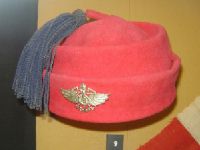
Cameroon Fez, similar to those worn by the
Togo Polizeitruppe
(See Imperial War Museum
Collection Page)
IWM Collection
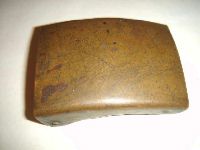
African Soldier's Buckle
(See
Belt Buckles
Details Page)
Photo © Doppler |
| |
|
|
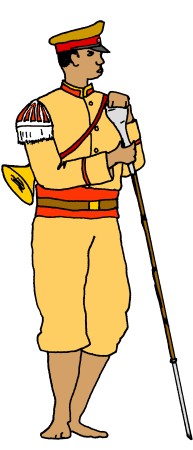 |
 |
 |
|
Figure 6
Police
Music Master
c1914 |
Figure 7
Police
NCO
c1914 |
Figure 8
Police
Senior NCO
c1914 |
Figure 6 is based on a photograph
of a Togo Police Master Musician taken in Lome sometime between 1910 and 1914. He
wears the same khaki uniform and peaked cap as the previous figures. On
his shoulders he wears musicians swallow's nests with a fringe denoting
him to be a master musician. This is unusual as the Music Masters in
other colonies were all German. Note he carries a brass horn slung over
his shoulder and a band leader's marching staff.
Figure 7 is based on a photograph
of a Togo Police NCO probably taken sometime between 1910 and 1914. He
wears the same khaki uniform and peaked cap as the previous figures. Note the three widely spaced chevrons worn
on both lower sleeves showing him to be a Sergeant. As mentioned above, Togo
Polizeitruppe NCO insignia varied in its positioning on the arm and also in
the size of the chevrons. Also note the medal, probably a German Warriors
Merit Medal ("Kriegerverdienstmedaille") for African troops in
German service from 1893 onwards (see Medals
Page).
Another point of interest is that this NCO wears a brass
belt buckle with a white metal imperial crown within a wreath- the style of
belt buckle usually worn only by German rather than African personnel in
Africa (see Belt
Buckles Details Page)
Figure 8 is based on a photograph
of a Togo Police NCO taken sometime between 1910 and 1914. He
wears the same khaki uniform and peaked cap as the previous figures. In
this case the rank insignia is shown in the from of four relatively small
chevrons worn on both upper sleeves, showing him to be a Feldwebel.
Feldwebels in Togo were entitled to carry a sword unlike senior African NCOs
in other German colonies. An article by
Marius Foerster notes on P33 that there was only one African Feldwebel
based in Lome in the Togo Polizeitruppe, so this figure is probably him, and
shows a unique uniform.
He wears a lanyard on his right
breast. I have up until this point found no descriptions of the Togo
Polizeitruppe wearing such items. It may be that it was an award worn only
by the senior NCO of the Togo Polizeitruppe on parade or possibly a
marksmanship award as usually worn by Germans in the Schutztruppe and
regular army (see
Specialist Insignia Page).
Also note the impressive medal bar worn on the
left breast. As mentioned above African troops were sometimes awarded bravery medals
but this NCO unusually has more than most. One period photograph (see below) shows his medals more closely. They can be made
out to be from left to right in order of seniority, the German Warriors
Merit Medal for African troops, the 1908 Mecklenburg-Schwerin Africa Medal
(for those who had accompanied Duke Adolf Friedrich of Mecklenburg-Schwerin
on his expedition across Central Africa in 1907-08) and the Prussian Crown
Medal (see Medals Page).
| |
Period Photographs of the
Togo Polizeitruppe |
|
| |

Togo Polizeitruppe c. late 1880s
This photograph shows Haussa recruits wearing the white naval
style uniform with red sash and fez. The German NCOs on the left
wear white tropical uniforms. The bearded man on the far left with a
white peaked field cap (with what may be a red hatband) while the
other German wears a white tropical helmet.
Photo from Bundesarchiv /
WikiCommons
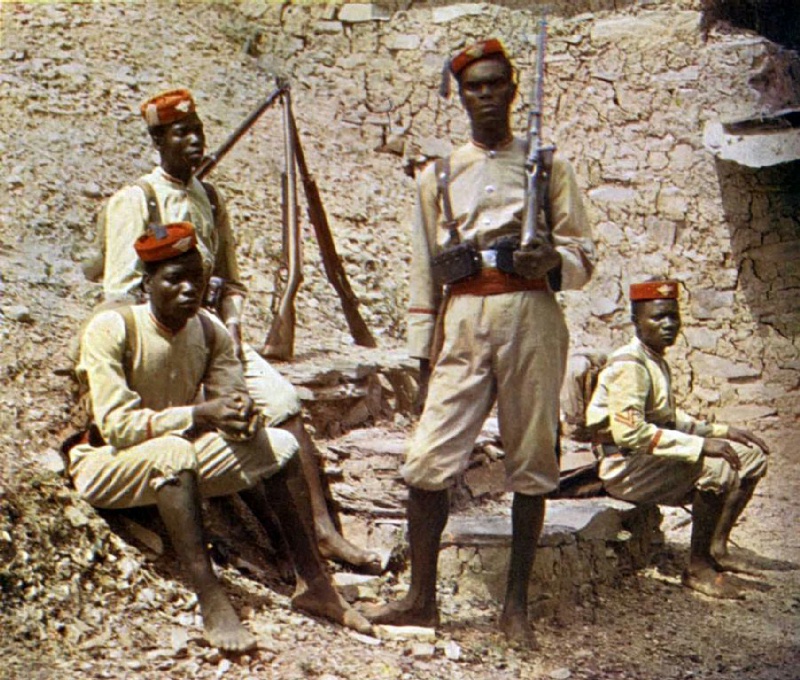
Togo Polizeitruppe
This early colour photograph clearly shows the khaki uniform,
red sash and fez with the imperial eagle. They are armed with the
JB71 rifle. Note the rank chevrons of the Unteroffizier on the
right.
Photo from
Wikipedia
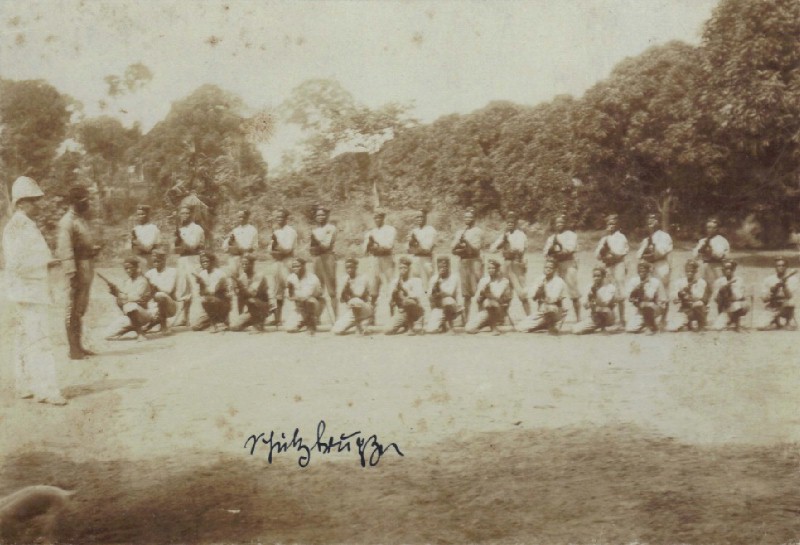
Togo Polizeitruppe
This photograph shows the Togo Polizeitruppe in training. The African
soldiers wear the 1894 khaki uniform with the red fez.
Note the German
NCO on the left in white uniform and tropical helmet.
Photo © Mark Skurka see For
Sale Page
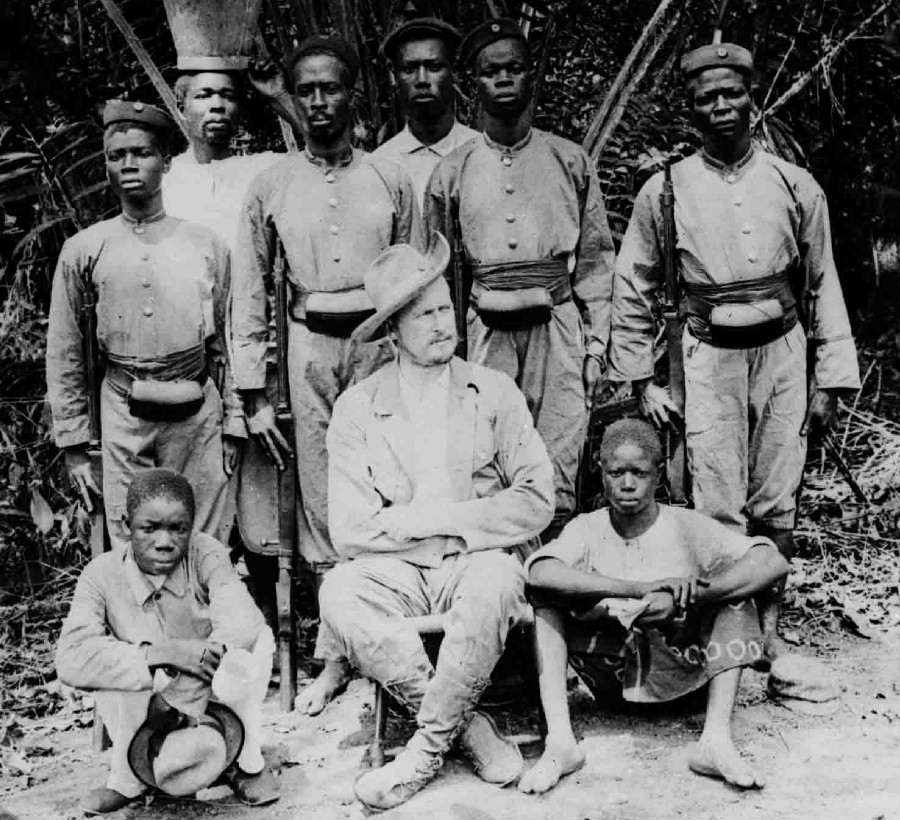
Togo Polizeitruppe
This photograph shows soldiers of the Togo Polizeitruppe with their
German commander and his African servants. The Polizeitruppe soldiers
wear the khaki uniform with red sashes and fezzes. Unusually the fezzes
have the Impeirla cockade rather than the usual Imperial eagle.
Photo ©
Frankfurt University Koloniales Bildarchiv
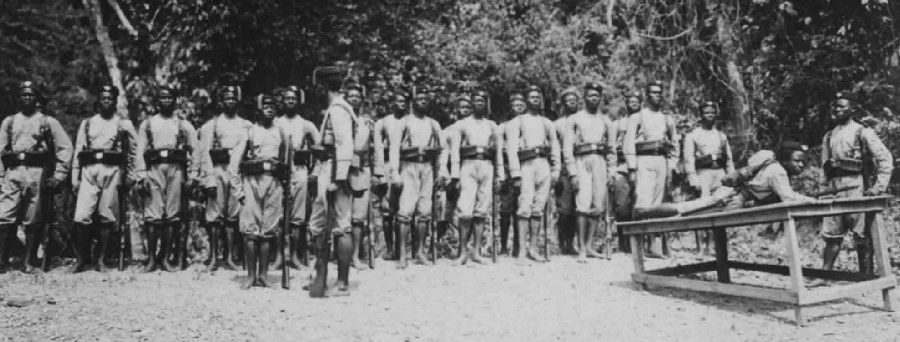
Togo Polizeitruppe in Rifle Training
They wear the khaki uniform with red rolled fez. Note the full equipment
worn with ammunition pouches and backpack, worn over the red sash.
Photo ©
Frankfurt University Koloniales Bildarchiv
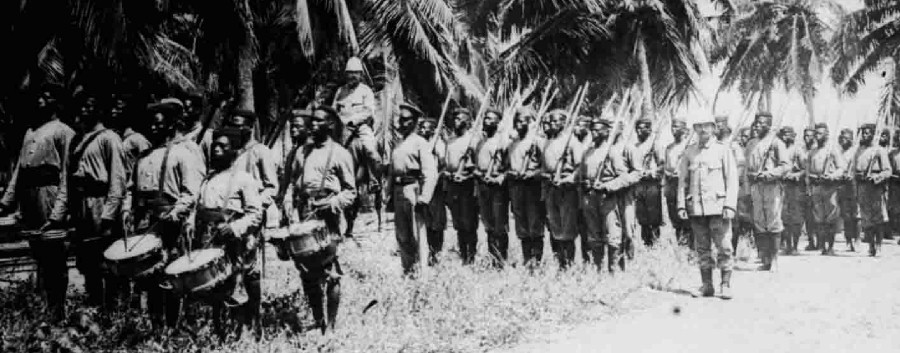
Togo Polizeitruppe on Parade
They wear the khaki uniform with red rolled fez. The African NCO behind
the band wears a khaki peaked field cap. Note that the musicians of the
band do not wear swallows nests. The German NCOs wear khaki uniforms
with white tropical helmets.
Photo ©
Frankfurt University Koloniales Bildarchiv
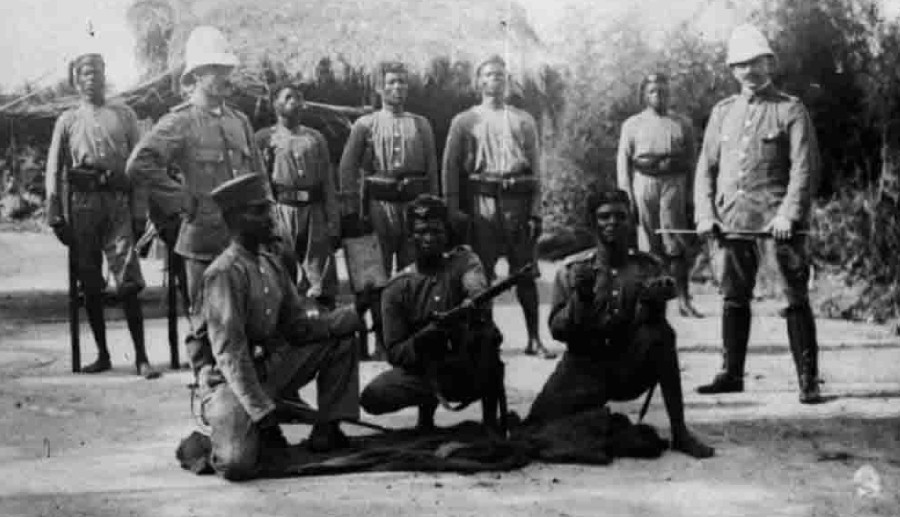
Togo Polizeitruppe in Training
They wear the khaki uniform (unusually with shoulder straps) with red rolled fez. The African NCO
kneeling on the left wears a khaki peaked field cap. The German NCOs
again wear khaki uniforms with white tropical helmets. An Imperial
cockade is visible on the front of the helmet worn by the German NCO on
the left.
Photo ©
Frankfurt University Koloniales Bildarchiv
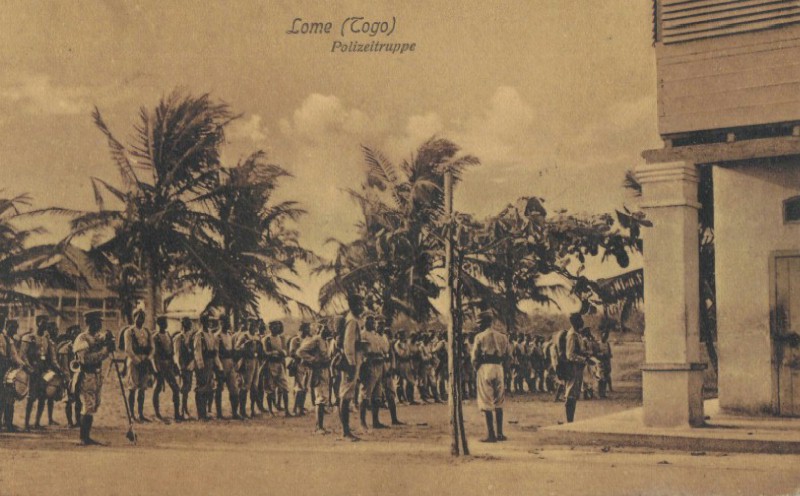
Togo Polizeitruppe on Parade in Lome
This photographs shows the Togo Polizeitruppe on parade in
the colony's captial, Lome. They
wear the khaki uniform with red edgings. Most of them wear the red
fez with some of the NCOs wearing the newly introduced khaki field
cap. Note the musicians on the left of the photograph with swallows
nest insignia on their shoulders.
Photo © Mark Skurka see For
Sale Page
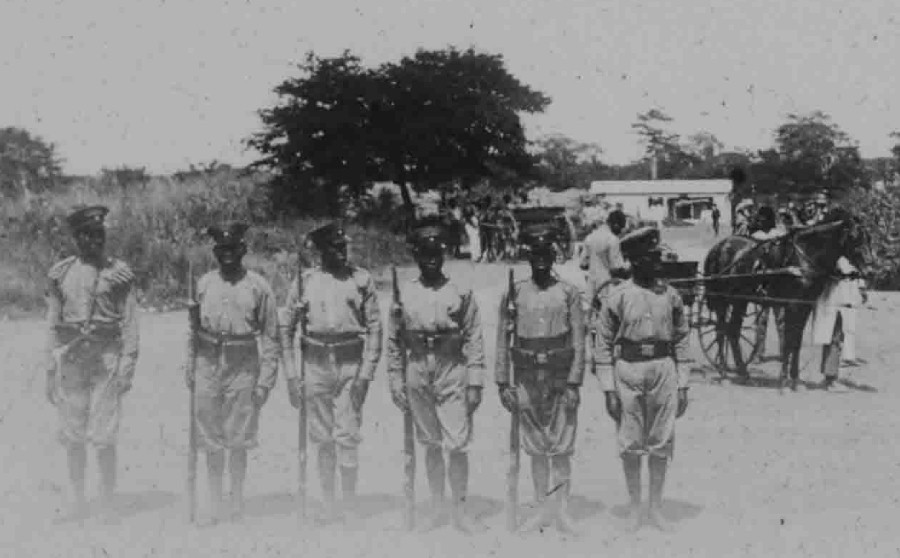
Togo Polizeitruppe
They wear the khaki uniform with red sash and khaki peaked field cap.
Note the trumpeter on the left wearing swallows nests.
Photo ©
Frankfurt University Koloniales Bildarchiv
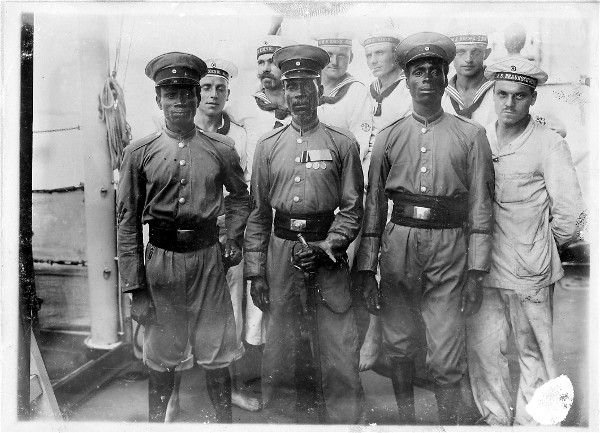
Togo Polizeitruppe NCOs with German Sailors
The Polizeitruppe wear the
Togo khaki uniform with peaked
cap. Interestingly all three have khaki shoulder straps
on their uniforms which were not common practice in Togo. Note the
red rank chevrons on both arms. The NCO on the right has a single
chevron and is therefore a Gefreiter, on the left of the photo is an
Unteroffizier with two chevrons. The figure in the centre is the
most interesting with the four chevrons and a sword
of the Feldwebel. On his left breast
he has three medals, they are the German Warriors Merit Medal
second class in silver, the Mecklenburg Schwerin Africa
Medal and the Prussian Crown Order Medal. This Feldwebel
also wears a German naval or Schutztruppe other rnaks belt buckle
with the imperial crown within the "Gott Mit Uns" motto. The other
two NCOs wear the more common plain African other ranks belt buckle.
Photo ©
Andreas M. Schulze Ising of
Medal Net
first shown on
Medals
of a Togo Polizeitruppe NCO at the
Gentlemen's Military
Interest Club
|
|
Main Sources
"Die Deutsche Schutztruppe 1889/1918" by Werner Haupt
"Die Kaiserliche Schutz- und Polizeitruppe für Afrika" by Reinhard
Schneider
"Askari und Fitafita - Farbiger Söldner in den deutschen Kolonien" by
Thomas Morlang
"Colonial
Armies: Africa 1850 to 1918" by Peter
Abbott
"Imperial German Field
Uniforms and Equipment 1907-1918 Vol 3" by Johan
Somers
"Uniformen der Marine und Schutztruppen"
published by Waldorff Astoria Cigarette Cards
"Official History of the War- Military Operations in Togoland and
the Cameroons" by Brigadier General F.J. Moberley
...and photographs in the
Frankfurt
University Archives



















